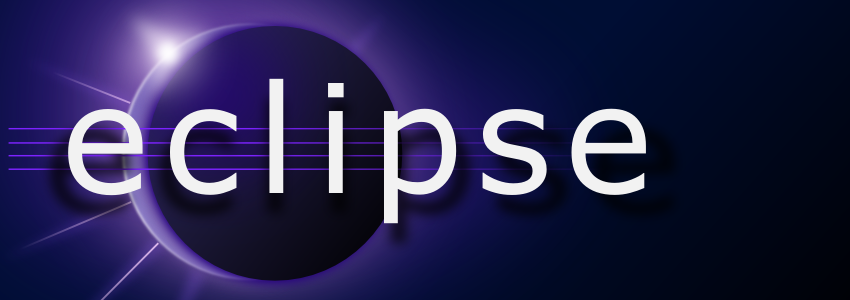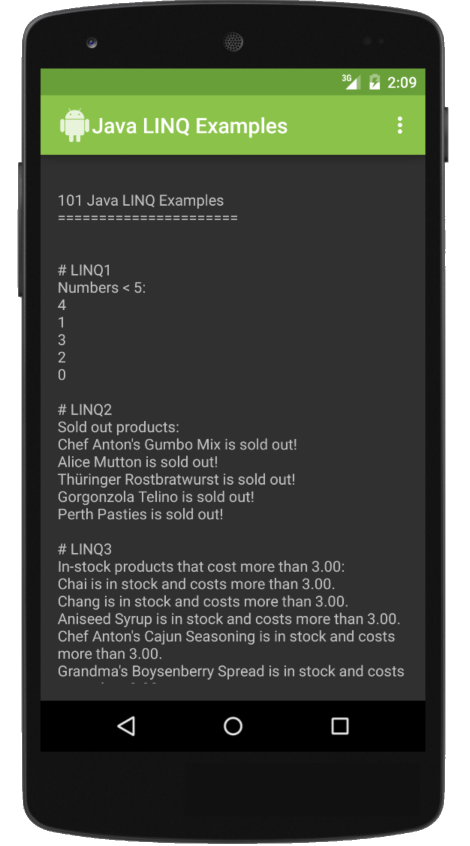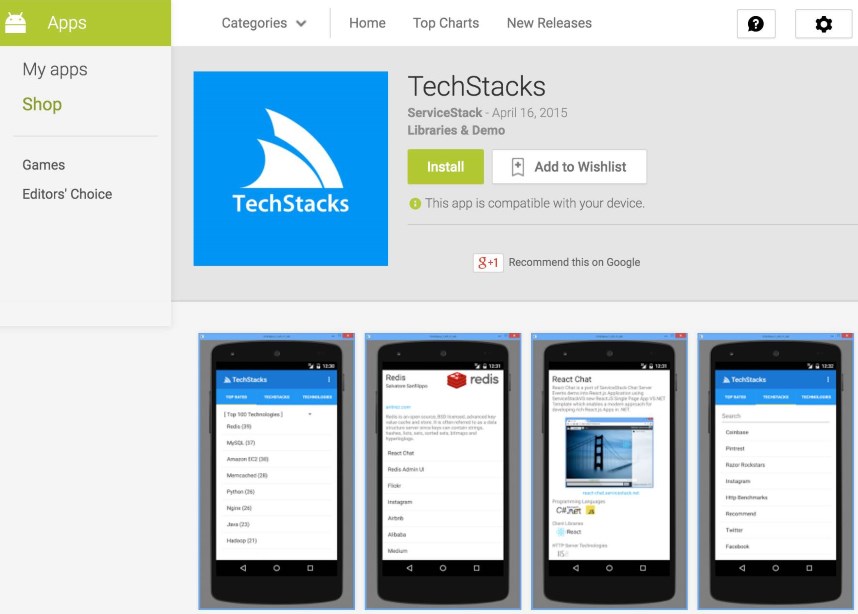
ServiceStack IDEA Android Studio Plugin
Like the existing IDE integrations before it, the ServiceStack IDEA plugin provides Add ServiceStack Reference functionality to Android Studio - the official Android IDE.
The ServiceStackIDEA plugin also includes support for IntelliJ Maven projects giving Java devs a productive and familiar development experience whether they're creating Android Apps or pure cross-platform Java clients.
Java Android Example using Android Studio
Install ServiceStack IDEA from the Plugin repository
The ServiceStack IDEA is now available to install directly from within IntelliJ or Android Studio IDE Plugins Repository, to Install Go to:
File -> Settings...Main Menu Item- Select Plugins on left menu then click Browse repositories... at bottom
- Search for ServiceStack and click Install plugin
- Restart to load the installed ServiceStack IDEA plugin
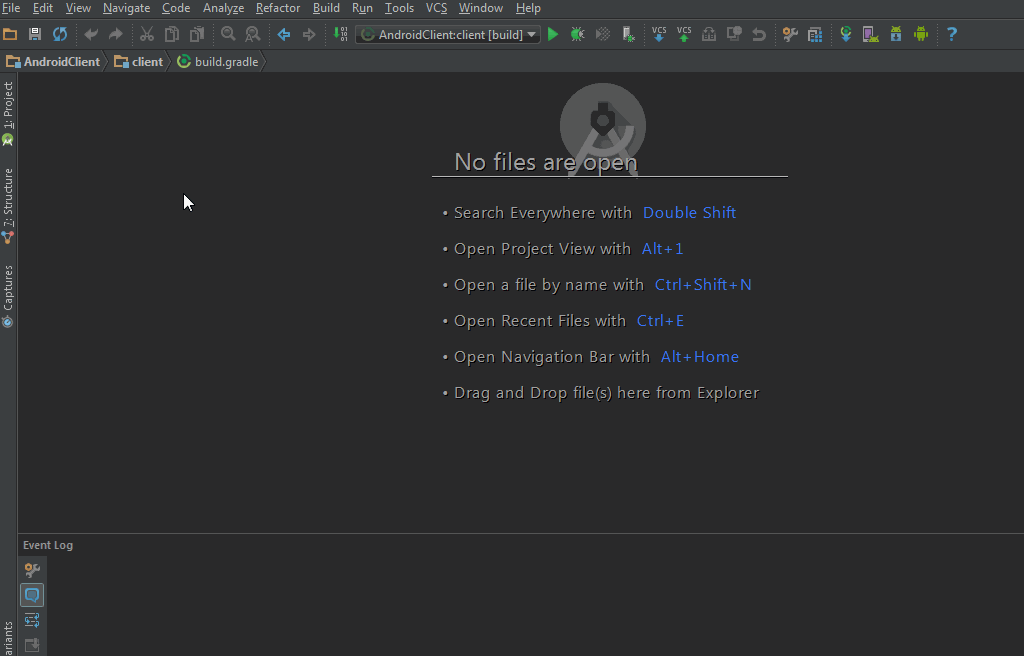
Download and Install ServiceStack IDEA Manually
The ServiceStack AndroidStudio Plugin can also be downloaded directly from the JetBrains plugins website at:
ServiceStackIDEA.zip
After downloading the plugin above, install it in Android Studio by:
- Click on
File -> Settingsin the Main Menu to open the Settings Dialog - Select Plugins settings screen
- Click on Install plugin from disk... to open the File Picker Dialog
- Browse and select the downloaded ServiceStackIDEA.zip
- Click OK then Restart Android Studio
Installing ServiceStackEclipse Plugin on Eclipse
See the ServiceStack Eclipse Home Page for instructions on installing the ServiceStackEclipse Plugin from the Eclipse MarketPlace and how to Add and Update ServiceStack References directly from within the Eclipse IDE.
Manually adding a dependency in Android Studio
Whilst the ServiceStack IDEA Plugin will automatically add the Gradle reference to your projects build.gradle, you can also manually add the reference by adding the net.servicestack:android dependency as seen below:
dependencies {
implementation fileTree(dir: 'libs', include: ['*.jar'])
implementation 'net.servicestack:android:1.1.0'
}
This also lets you to change which ServiceStack Client library version you want to use, the example above uses 1.0.48.
Add ServiceStack Reference
If you've previously used Add ServiceStack Reference in any of the supported IDE's before, you'll be instantly familiar with Add ServiceStack Reference in Android Studio. The only additional field is Package, required in order to comply with Java's class definition rules.
To add a ServiceStack Reference, right-click (or press Ctrl+Alt+Shift+R) on the Package folder in your Java sources where you want to add the POJO DTO's. This will bring up the New > Items Context Menu where you can click on the ServiceStack Reference... Menu Item to open the Add ServiceStack Reference Dialog:

The Add ServiceStack Reference Dialog will be partially populated with the selected Package with the package where the Dialog was launched from and the File Name defaulting to dto.java where the Plain Old Java Object (POJO) DTO's will be added to. All that's missing is the url of the remote ServiceStack instance you wish to generate the DTO's for, e.g: https://techstacks.io:
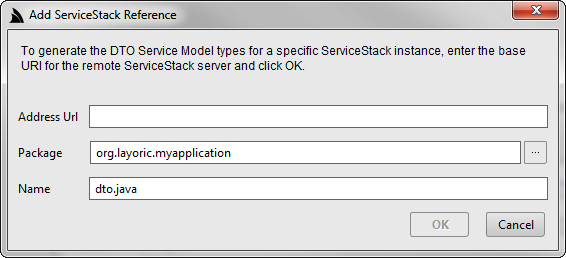
Clicking OK will add the dto.java file to your project and modifies the current Project's build.gradle file dependencies list with the new net.servicestack:android dependency containing the Java JSON ServiceClients which is used together with the remote Servers DTO's to enable its typed Web Services API:

INFO
As the Module's build.gradle file was modified you'll need to click on the Sync Now link in the top yellow banner to sync the build.gradle changes which will install or remove any modified dependencies
Update ServiceStack Reference
Like other Native Type languages, the generated DTO's can be further customized by modifying any of the options available in the header comments:
/* Options:
Date: 2025-06-04 09:52:41
Version: 8.80
Tip: To override a DTO option, remove "//" prefix before updating
BaseUrl: https://blazor-vue.web-templates.io
//Package:
//GlobalNamespace: dtos
//AddPropertyAccessors: True
//SettersReturnThis: True
//AddServiceStackTypes: True
//AddResponseStatus: False
//AddDescriptionAsComments: True
//AddImplicitVersion:
//IncludeTypes:
//ExcludeTypes:
//TreatTypesAsStrings:
//DefaultImports: java.math.*,java.util.*,java.io.InputStream,net.servicestack.client.*,com.google.gson.annotations.*,com.google.gson.reflect.*
*/
...
For example the package name can be changed by uncommenting the Package: option with the new package name, then either right-click on the file to bring up the file context menu or use Android Studio's Alt+Enter keyboard shortcut then click on Update ServiceStack Reference to update the DTO's with any modified options:

JsonServiceClient API
The goal of Native Types is to provide a productive end-to-end typed API to facilitate consuming remote services with minimal effort, friction and cognitive overhead. One way we achieve this is by promoting a consistent, forwards and backwards-compatible message-based API that's works conceptually similar on every platform where each language consumes remote services by sending Typed DTO's using a reusable Generic Service Client and a consistent client library API.
To maximize knowledge sharing between different platforms, the Java ServiceClient API is modelled after the .NET Service Clients API closely, as allowed within Java's language and idiomatic-style constraints.
Thanks to C#/.NET being heavily inspired by Java, the resulting Java JsonServiceClient ends up bearing a close resemblance with .NET's Service Clients. The primary differences being due to language limitations like Java's generic type erasure and lack of language features like property initializers making Java slightly more verbose to work with, however as Add ServiceStack Reference is able to take advantage of code-gen we're able to mitigate most of these limitations to retain a familiar developer UX.
The ServiceClient.java interface provides a good overview on the API available on the concrete JsonServiceClient class:
public interface ServiceClient {
boolean getAlwaysSendBasicAuthHeaders();
void setBearerToken(String value);
String getBearerToken();
void setTokenCookie(String value);
void setRefreshToken(String bearerToken);
String getRefreshToken();
void setRefreshTokenCookie(String value);
void setAlwaysSendBasicAuthHeaders(boolean value);
void setCredentials(String userName, String password);
<TResponse> TResponse send(IReturn<TResponse> request);
void send(IReturnVoid request);
<TResponse> TResponse get(IReturn<TResponse> request);
void get(IReturnVoid request);
<TResponse> TResponse get(IReturn<TResponse> request, Map<String,String> queryParams);
<TResponse> TResponse get(String path, Class responseType);
<TResponse> TResponse get(String path, Type responseType);
HttpURLConnection get(String path);
<TResponse> TResponse post(IReturn<TResponse> request);
void post(IReturnVoid request);
<TResponse> TResponse post(String path, Object request, Class responseType);
<TResponse> TResponse post(String path, Object request, Type responseType);
<TResponse> TResponse post(String path, byte[] requestBody, String contentType, Class responseType);
<TResponse> TResponse post(String path, byte[] requestBody, String contentType, Type responseType);
HttpURLConnection post(String path, byte[] requestBody, String contentType);
<TResponse> TResponse put(IReturn<TResponse> request);
void put(IReturnVoid request);
<TResponse> TResponse put(String path, Object request, Class responseType);
<TResponse> TResponse put(String path, Object request, Type responseType);
<TResponse> TResponse put(String path, byte[] requestBody, String contentType, Class responseType);
<TResponse> TResponse put(String path, byte[] requestBody, String contentType, Type responseType);
HttpURLConnection put(String path, byte[] requestBody, String contentType);
<TResponse> TResponse delete(IReturn<TResponse> request);
void delete(IReturnVoid request);
<TResponse> TResponse delete(IReturn<TResponse> request, Map<String,String> queryParams);
<TResponse> TResponse delete(String path, Class responseType);
<TResponse> TResponse delete(String path, Type responseType);
HttpURLConnection delete(String path);
void setCookie(String name, String value);
void setCookie(String name, String value, Long expiresInSecs);
void clearCookies();
String getCookieValue(String name);
String getTokenCookie();
String getRefreshTokenCookie();
<TResponse> TResponse postFileWithRequest(IReturn<TResponse> request, UploadFile file);
<TResponse> TResponse postFileWithRequest(Object request, UploadFile file, Object responseType);
<TResponse> TResponse postFileWithRequest(String path, Object request, UploadFile file, Object responseType);
<TResponse> TResponse postFilesWithRequest(IReturn<TResponse> request, UploadFile[] files);
<TResponse> TResponse postFilesWithRequest(Object request, UploadFile[] files, Object responseType);
<TResponse> TResponse postFilesWithRequest(String path, Object request, UploadFile[] files, Object responseType);
}
The primary concession is due to Java's generic type erasure which forces the addition overloads that include a Class parameter for specifying the response type to deserialize into as well as a Type parameter overload which does the same for generic types. These overloads aren't required for API's that accept a Request DTO annotated with IReturn<T> interface marker as we're able to encode the Response Type in code-generated Request DTO classes.
JsonServiceClient Usage
To get started you'll just need an instance of JsonServiceClient initialized with the BaseUrl of the remote ServiceStack instance you want to access, e.g:
JsonServiceClient client = new JsonServiceClient("https://techstacks.io");
INFO
The JsonServiceClient is made available after the net.servicestack:android package is automatically added to your build.gradle when adding a ServiceStack reference.
Typical usage of the Service Client is the same in .NET where you just need to send a populated Request DTO and the Service Client will return a populated Response DTO, e.g:
AppOverviewResponse r = client.get(new AppOverview());
ArrayList<Option> allTiers = r.getAllTiers();
ArrayList<TechnologyInfo> topTech = r.getTopTechnologies();
As Java doesn't have type inference you'll need to specify the Type when declaring a variable. Whilst the public instance fields of the Request and Response DTO's are accessible directly, the convention in Java is to use the property getters and setters that are automatically generated for each DTO property as seen above.
Custom Example Usage
We'll now go through some of the other API's to give you a flavour of what's available. When preferred you can also consume Services using a custom route by supplying a string containing the route and/or Query String. As no type info is available you'll need to specify the Response DTO class to deserialize the response into, e.g:
OverviewResponse response = client.get("/overview", OverviewResponse.class);
The path can either be a relative or absolute url in which case the BaseUrl is ignored and the full absolute url is used instead, e.g:
OverviewResponse response = client.get("https://techstacks.io/overview", OverviewResponse.class);
When initializing the Request DTO you can take advantage of the generated setters which by default return this allowing them to be created and chained in a single expression, e.g:
GetTechnology request = new GetTechnology()
.setSlug("servicestack");
GetTechnologyResponse response = client.get(request);
AutoQuery Example Usage
You can also send requests composed of both a Typed DTO and untyped String Dictionary by providing a Java Map of additional args. This is typically used when querying implicit conventions in AutoQuery services, e.g:
QueryResponse<Technology> response = client.get(new FindTechnologies(),
Utils.createMap("DescriptionContains","framework"));
The Utils.createMap() API is included in the Utils.java static class which contains a number of helpers to simplify common usage patterns and reduce the amount of boiler plate required for common tasks, e.g they can also simplify reading raw bytes or raw String from a HTTP Response. Here's how you can download an image bytes using a custom JsonServiceClient HTTP Request and load it into an Android Image Bitmap:
HttpURLConnection httpRes = client.get("https://servicestack.net/img/logo.png");
byte[] imgBytes = Utils.readBytesToEnd(httpRes);
Bitmap img = BitmapFactory.decodeByteArray(imgBytes, 0, imgBytes.length);
Integrated Basic Auth
HTTP Basic Auth is supported in JsonServiceClient following the implementation in .NET Service Client
where you can specify the users credentials and whether you always want to send Basic Auth with each request by:
client.setCredentials(userName, password);
client.setAlwaysSendBasicAuthHeaders(true);
TestAuthResponse response = client.get(new TestAuth());
It also supports processing challenged 401 Auth HTTP responses where it will transparently replay the failed request with the Basic Auth Headers:
client.setCredentials(userName, password);
TestAuthResponse response = client.get(new TestAuth());
Although this has the additional latency of waiting for a failed 401 response before sending an authenticated request.
Cookies-enabled Service Client
The JsonServiceClient initializes a CookieManager in its constructor to enable any Cookies received to
be added on subsequent requests to allow you to make authenticated requests after authenticating, e.g:
AuthenticateResponse authResponse = client.post(new Authenticate()
.setProvider("credentials")
.setUserName(userName)
.setPassword(password));
TestAuthResponse response = client.get(new TestAuth());
Uploading Files
The postFileWithRequest method can be used to upload a file with an API Request.
Java Speech to Text
Here's an example calling AI Server's SpeechToText API:
byte[] audioBytes = Files.readAllBytes(Paths.get("audio.wav"));
var response = client.postFileWithRequest(request,
new UploadFile("audio", "audio.wav", "audio/wav", audioBytes));
To upload multiple files use postFilesWithRequest.
AndroidServiceClient
Unlike .NET, Java doesn't have an established Async story or any language support that simplifies execution and composition of Async tasks, as a result the Async story on Android is fairly fragmented with multiple options built-in for executing non-blocking tasks on different threads including:
- Thread
- Executor
- HandlerThread
- AsyncTask
- Service
- IntentService
- AsyncQueryHandler
- Loader
JayWay's Oredev presentation on Efficient Android Threading provides a good overview of the different threading strategies above with their use-cases, features and pitfalls. Unfortunately none of the above options enable a Promise/Future-like API which would've been ideal in maintaining a consistent Task-based Async API across all ServiceStack Clients. Of all the above options the new Android AsyncTask ended up the most suitable option, requiring the least effort for the typical Service Client use-case of executing non-blocking WebService Requests and having their results called back on the Main UI thread.
AsyncResult
To enable an even simpler Async API decoupled from Android, we've introduced a higher-level AsyncResult class which allows capturing of Async callbacks using an idiomatic anonymous Java class. AsyncResult is modelled after jQuery.ajax and allows specifying success(), error() and complete() callbacks as needed.
AsyncServiceClient API
Using AsyncResult lets us define a pure Java AsyncServiceClient interface that's decoupled from any specific threading implementation, i.e:
public interface AsyncServiceClient {
public <T> void getAsync(IReturn<T> request, final AsyncResult<T> asyncResult);
public <T> void getAsync(IReturn<T> request, final Map<String, String> queryParams, final AsyncResult<T> asyncResult);
public <T> void getAsync(String path, final Class responseType, final AsyncResult<T> asyncResult);
public <T> void getAsync(String path, final Type responseType, final AsyncResult<T> asyncResult);
public void getAsync(String path, final AsyncResult<byte[]> asyncResult);
public <T> void postAsync(IReturn<T> request, final AsyncResult<T> asyncResult);
public <T> void postAsync(String path, final Object request, final Class responseType, final AsyncResult<T> asyncResult);
public <T> void postAsync(String path, final Object request, final Type responseType, final AsyncResult<T> asyncResult);
public <T> void postAsync(String path, final byte[] requestBody, final String contentType, final Class responseType, final AsyncResult<T> asyncResult);
public <T> void postAsync(String path, final byte[] requestBody, final String contentType, final Type responseType, final AsyncResult<T> asyncResult);
public void postAsync(String path, final byte[] requestBody, final String contentType, final AsyncResult<byte[]> asyncResult);
public <T> void putAsync(IReturn<T> request, final AsyncResult<T> asyncResult);
public <T> void putAsync(String path, final Object request, final Class responseType, final AsyncResult<T> asyncResult);
public <T> void putAsync(String path, final Object request, final Type responseType, final AsyncResult<T> asyncResult);
public <T> void putAsync(String path, final byte[] requestBody, final String contentType, final Class responseType, final AsyncResult<T> asyncResult);
public <T> void putAsync(String path, final byte[] requestBody, final String contentType, final Type responseType, final AsyncResult<T> asyncResult);
public void putAsync(String path, final byte[] requestBody, final String contentType, final AsyncResult<byte[]> asyncResult);
public <T> void deleteAsync(IReturn<T> request, final AsyncResult<T> asyncResult);
public <T> void deleteAsync(IReturn<T> request, final Map<String, String> queryParams, final AsyncResult<T> asyncResult);
public <T> void deleteAsync(String path, final Class responseType, final AsyncResult<T> asyncResult);
public <T> void deleteAsync(String path, final Type responseType, final AsyncResult<T> asyncResult);
public void deleteAsync(String path, final AsyncResult<byte[]> asyncResult);
}
The AsyncServiceClient interface is implemented by the AndroidServiceClient concrete class which behind-the-scenes uses an Android AsyncTask to implement its Async API's.
Whilst the AndroidServiceClient is contained in the net.servicestack:android dependency and only works in Android, the JsonServiceClient instead is contained in a seperate pure Java net.servicestack:client dependency which can be used independently to provide a typed Java API for consuming ServiceStack Services from any Java application.
Async API Usage
To make use of Async API's in an Android App (which you'll want to do to keep web service requests off the Main UI thread), you'll instead need to use an instance of AndroidServiceClient which as it inherits JsonServiceClient can be used to perform both Sync and Async requests:
AndroidServiceClient client = new AndroidServiceClient("https://techstacks.io");
Like other Service Clients, there's an equivalent Async API matching their Sync counterparts which differs by ending with an Async suffix which instead of returning a typed response, fires a success(TResponse) or error(Exception) callback with the typed response, e.g:
client.getAsync(new AppOverview(), new AsyncResult<AppOverviewResponse>(){
@Override
public void success(AppOverviewResponse r) {
ArrayList<Option> allTiers = r.getAllTiers();
ArrayList<TechnologyInfo> topTech = r.getTopTechnologies();
}
});
Which just like the JsonServiceClient examples above also provide a number of flexible options to execute Custom Async Web Service Requests, e.g:
client.getAsync("/overview", OverviewResponse.class, new AsyncResult<OverviewResponse>(){
@Override
public void success(OverviewResponse response) {
}
});
Example calling a Web Service with an absolute url:
client.getAsync("https://techstacks.io/overview", OverviewResponse.class, new AsyncResult<OverviewResponse>() {
@Override
public void success(OverviewResponse response) {
}
});
Async AutoQuery Example
Example calling an untyped AutoQuery Service with additional Dictionary String arguments:
client.getAsync(request, Utils.createMap("DescriptionContains", "framework"),
new AsyncResult<QueryResponse<Technology>>() {
@Override
public void success(QueryResponse<Technology> response) {
}
});
Download Raw Image Async Example
Example downloading raw Image bytes and loading it into an Android Image Bitmap:
client.getAsync("https://servicestack.net/img/logo.png", new AsyncResult<byte[]>() {
@Override
public void success(byte[] imgBytes) {
Bitmap img = BitmapFactory.decodeByteArray(imgBytes, 0, imgBytes.length);
}
});
Send Raw String or byte[] Requests
You can easily get the raw string Response from Request DTO's that return are annotated with IReturn<string>, e.g:
public static class HelloString implements IReturn<String> { ... }
String response = client.get(new HelloString().setName("World"));
You can also specify that you want the raw UTF-8 byte[] or String response instead of a the deserialized Response DTO by specifying
the Response class you want returned, e.g:
byte[] response = client.get("/hello?Name=World", byte[].class);
Java HTTP Marker Interfaces
Like the .NET and Swift Service Clients, the HTTP Interface markers are also annotated on Java DTO's and let you use the same
send API to send Requests via different HTTP Verbs, e.g:
public static class HelloByGet implements IReturn<HelloResponse>, IGet { ... }
public static class HelloByPut implements IReturn<HelloResponse>, IPut { ... }
HelloResponse response = client.send(new HelloByGet().setName("World")); //GET
client.sendAsync(new HelloByPut().setName("World"), //PUT
new AsyncResult<HelloResponse>() {
@Override
public void success(HelloResponse response) { }
});
IReturnVoid Support
New Sync/Async overloads have been added for IReturnVoid Request DTO's:
client.delete(new DeleteCustomer().setId(1));
Typed Error Handling
Thanks to Java also using typed Exceptions for error control flow, error handling in Java will be instantly familiar to C# devs which also throws a typed WebServiceException containing the remote servers structured error data:
ThrowType request = new ThrowType()
.setType("NotFound")
.setMessage("not here");
try {
ThrowTypeResponse response = testClient.post(request);
}
catch (WebServiceException webEx) {
ResponseStatus status = webEx.getResponseStatus();
status.getMessage(); //= not here
status.getStackTrace(); //= (Server StackTrace)
}
Likewise structured Validation Field Errors are also accessible from the familiar ResponseStatus DTO, e.g:
ThrowValidation request = new ThrowValidation()
.setEmail("invalidemail");
try {
client.post(request);
} catch (WebServiceException webEx){
ResponseStatus status = webEx.getResponseStatus();
ResponseError firstError = status.getErrors().get(0);
firstError.getErrorCode(); //= InclusiveBetween
firstError.getMessage(); //= 'Age' must be between 1 and 120. You entered 0.
firstError.getFieldName(); //= Age
}
Async Error Handling
Async Error handling differs where in order to access the WebServiceException you'll need to implement the error(Exception) callback, e.g:
client.postAsync(request, new AsyncResult<ThrowTypeResponse>() {
@Override
public void error(Exception ex) {
WebServiceException webEx = (WebServiceException)ex;
ResponseStatus status = webEx.getResponseStatus();
status.getMessage(); //= not here
status.getStackTrace(); //= (Server StackTrace)
}
});
Async Validation Errors are also handled in the same way:
client.postAsync(request, new AsyncResult<ThrowValidationResponse>() {
@Override
public void error(Exception ex) {
WebServiceException webEx = (WebServiceException)ex;
ResponseStatus status = webEx.getResponseStatus();
ResponseError firstError = status.getErrors().get(0);
firstError.getErrorCode(); //= InclusiveBetween
firstError.getMessage(); //= 'Age' must be between 1 and 120. You entered 0.
firstError.getFieldName(); //= Age
}
}
JsonServiceClient Error Handlers
To make it easier to generically handle Web Service Exceptions, the Java Service Clients also support static Global Exception handlers by assigning AndroidServiceClient.GlobalExceptionFilter, e.g:
AndroidServiceClient.GlobalExceptionFilter = new ExceptionFilter() {
@Override
public void exec(HttpURLConnection res, Exception ex) {
//...
}
};
As well as local Exception Filters by specifying a handler for client.ExceptionFilter, e.g:
client.ExceptionFilter = new ExceptionFilter() {
@Override
public void exec(HttpURLConnection res, Exception ex) {
//...
}
};
Java generated DTO Types
Our goal with Java Add ServiceStack Reference is to ensure a high-fidelity, idiomatic translation within the constraints of Java language and its built-in libraries, where .NET Server DTO's are translated into clean, conventional Java POJO's where .NET built-in Value Types mapped to their equivalent Java data Type.
To see what this ends up looking up we'll go through some of the Generated Test Services to see how they're translated in Java.
.NET Attributes translated into Java Annotations
By inspecting the HelloAllTypes Request DTO we can see that C# Metadata Attributes e.g. [Route("/all-types")] are also translated into the typed Java Annotations defined in the net.servicestack:client dependency. But as Java only supports defining a single Annotation of the same type, any subsequent .NET Attributes of the same type are emitted in comments.
Terse, typed API's with IReturn interfaces
Java Request DTO's are also able to take advantage of the IReturn<TResponse> interface marker to provide its terse, typed generic API but due to Java's Type erasure the Response Type also needs to be encoded in the Request DTO as seen by the responseType field and getResponseType() getter:
@Route("/all-types")
public static class HelloAllTypes implements IReturn<HelloAllTypesResponse>
{
public String name = null;
public AllTypes allTypes = null;
public String getName() { return name; }
public HelloAllTypes setName(String value) { this.name = value; return this; }
public AllTypes getAllTypes() { return allTypes; }
public HelloAllTypes setAllTypes(AllTypes value) { this.allTypes = value; return this; }
private static Object responseType = HelloAllTypesResponse.class;
public Object getResponseType() { return responseType; }
}
Getters and Setters generated for each property
Another noticeable feature is the Java getters and setters property convention are generated for each public field with setters returning itself allowing for multiple setters to be chained within a single expression.
To comply with Gson JSON Serialization rules, the public DTO fields are emitted in the same JSON naming convention as the remote ServiceStack server which for the test.servicestack.net Web Services, follows its camelCase naming convention that is configured in its AppHost with:
JsConfig.Init(new Config { TextCase = TextCase.CamelCase });
Whilst the public fields match the remote server JSON naming convention, the getters and setters are always emitted in Java's camelCase convention to maintain a consistent API irrespective of the remote server configuration. To minimize API breakage they should be the preferred method to access DTO fields.
Java Type Conversions
By inspecting the AllTypes DTO fields we can see what Java Type each built-in .NET Type gets translated into. In each case it selects the most suitable concrete Java datatype available, inc. generic collections. We also see only reference types are used (i.e. instead of their primitive types equivalents) since DTO properties are optional and need to be nullable.
public static class AllTypes
{
public Integer id = null;
public Integer nullableId = null;
@SerializedName("byte") public Short Byte = null;
@SerializedName("short") public Short Short = null;
@SerializedName("int") public Integer Int = null;
@SerializedName("long") public Long Long = null;
public Integer uShort = null;
public Long uInt = null;
public BigInteger uLong = null;
@SerializedName("float") public Float Float = null;
@SerializedName("double") public Double Double = null;
public BigDecimal decimal = null;
public String string = null;
public Date dateTime = null;
public TimeSpan timeSpan = null;
public Date dateTimeOffset = null;
public UUID guid = null;
@SerializedName("char") public String Char = null;
public Date nullableDateTime = null;
public TimeSpan nullableTimeSpan = null;
public ArrayList<String> stringList = null;
public ArrayList<String> stringArray = null;
public HashMap<String,String> stringMap = null;
public HashMap<Integer,String> intStringMap = null;
public SubType subType = null;
...
}
The only built-in Value Type that didn't have a suitable built-in Java equivalent was TimeSpan. In this case it uses our new TimeSpan.java class which implements the same familiar API available in .NET's TimeSpan.
Something else you'll notice is that some fields are annotated with the @SerializedName() Gson annotation. This is automatically added for Java keywords - required since Java doesn't provide anyway to escape keyword identifiers. The first time a Gson annotation is referenced it also automatically includes the required Gson namespace imports. If needed, this can also be explicitly added by with:
JavaGenerator.AddGsonImport = true;
Java Enums
.NET enums are also translated into typed Java enums where basic enums end up as a straightforward translation, e.g:
public static enum BasicEnum
{
Foo,
Bar,
Baz;
}
Whilst as Java doesn't support integer Enum flags directly the resulting translation ends up being a bit more convoluted:
@Flags()
public static enum EnumFlags
{
@SerializedName("1") Value1(1),
@SerializedName("2") Value2(2),
@SerializedName("4") Value3(4);
private final int value;
EnumFlags(final int intValue) { value = intValue; }
public int getValue() { return value; }
}
Java Functional Utils
The Core Java Functional Utils required to run C#'s 101 LINQ Samples in Java are included in the net.servicestack:client Java package which as its compatible with Java 1.7, also runs on Android:
Whilst noticeably more verbose than most languages, it enables a functional style of programming that provides an alternative to imperative programming with mutating collections and eases porting efforts of functional code which can be mapped to its equivalent core functional method.
Java Configuration
The header comments in the generated DTO's allows for further customization of how the DTO's are generated which can then be updated with any custom Options provided using the Update ServiceStack Reference Menu Item in Android Studio. Options that are preceded by a single line Java comment // are defaults from the server which can be overridden.
To override a value, remove the // and specify the value to the right of the :. Any value uncommented will be sent to the server to override any server defaults.
/* Options:
Date: 2015-04-10 12:41:14
Version: 1
BaseUrl: https://techstacks.io
Package: net.servicestack.techstacks
//GlobalNamespace: dto
//AddPropertyAccessors: True
//SettersReturnThis: True
//AddServiceStackTypes: True
//AddResponseStatus: False
//AddImplicitVersion:
//IncludeTypes:
//ExcludeTypes:
//DefaultImports: java.math.*,java.util.*,net.servicestack.client.*,com.google.gson.annotations.*
*/
We'll go through and cover each of the above options to see how they affect the generated DTO's:
Package
Specify the package name that the generated DTO's are in:
Package: net.servicestack.techstacks
Will generate the package name for the generated DTO's as:
package net.servicestack.techstacks;
GlobalNamespace
Change the name of the top-level Java class container that all static POJO classes are generated in, e.g changing the GlobalNamespace to:
GlobalNamespace: techstacksdto
Will change the name of the top-level class to techstacksdto, e.g:
public class techstacksdto
{
...
}
Where all static DTO classes can be imported using the wildcard import below:
import net.servicestack.techstacksdto.*;
AddPropertyAccessors
By default getters and setters are generated for each DTO property, you can prevent this default with:
AddPropertyAccessors: false
Which will no longer generate any property accessors, leaving just public fields, e.g:
public static class AppOverviewResponse
{
public Date Created = null;
public ArrayList<Option> AllTiers = null;
public ArrayList<TechnologyInfo> TopTechnologies = null;
public ResponseStatus ResponseStatus = null;
}
SettersReturnThis
To allow for chaining DTO field setters returns itself by default, this can be changed to return void with:
SettersReturnThis: false
Which will change the return type of each setter to void:
public static class GetTechnology implements IReturn<GetTechnologyResponse>
{
public String Slug = null;
public String getSlug() { return Slug; }
public void setSlug(String value) { this.Slug = value; }
}
AddServiceStackTypes
Lets you exclude built-in ServiceStack Types and DTO's from being generated with:
AddServiceStackTypes: false
This will prevent Request DTO's for built-in ServiceStack Services like Authenticate from being emitted.
AddImplicitVersion
Lets you specify the Version number to be automatically populated in all Request DTO's sent from the client:
AddImplicitVersion: 1
Which will embed the specified Version number in each Request DTO, e.g:
public static class GetTechnology implements IReturn<GetTechnologyResponse>
{
public Integer Version = 1;
public Integer getVersion() { return Version; }
public GetTechnology setVersion(Integer value) { this.Version = value; return this; }
}
This lets you know what Version of the Service Contract that existing clients are using making it easy to implement ServiceStack's recommended versioning strategy.
IncludeTypes
Is used as a Whitelist that can be used to specify only the types you would like to have code-generated:
/* Options:
IncludeTypes: GetTechnology,GetTechnologyResponse
Will only generate GetTechnology and GetTechnologyResponse DTO's, e.g:
public class dto
{
public static class GetTechnologyResponse { ... }
public static class GetTechnology implements IReturn<GetTechnologyResponse> { ... }
}
Include Request DTO and its dependent types
You can include a Request DTO and all its dependent types with a .* suffix on the Request DTO, e.g:
/* Options:
IncludeTypes: GetTechnology.*
Which will include the GetTechnology Request DTO, the GetTechnologyResponse Response DTO and all Types that they both reference.
Include All Types within a C# namespace
If your DTOs are grouped into different namespaces they can be all included using the /* suffix, e.g:
/* Options:
IncludeTypes: MyApp.ServiceModel.Admin/*
This will include all DTOs within the MyApp.ServiceModel.Admin C# namespace.
Include All Services in a Tag Group
Services grouped by Tag can be used in the IncludeTypes where tags can be specified using braces in the format {tag} or {tag1,tag2,tag3}, e.g:
/* Options:
IncludeTypes: {web,mobile}
Or individually:
/* Options:
IncludeTypes: {web},{mobile}
ExcludeTypes
Is used as a Blacklist where you can specify which types you would like to exclude from being generated:
/* Options:
ExcludeTypes: GetTechnology,GetTechnologyResponse
Will exclude GetTechnology and GetTechnologyResponse DTO's from being generated.
DefaultImports
Lets you override the default import packages included in the generated DTO's:
java.math.*,java.util.*,net.servicestack.client.*,com.acme.custom.*
Will override the default imports with the ones specified, i.e:
import java.math.*;
import java.util.*;
import net.servicestack.client.*;
import com.acme.custom.*;
By default the generated DTO's do not require any Google's Gson-specific serialization hints, but when they're needed e.g. if your DTO's use Java keywords or are attributed with [DataMember(Name=...)] the required Gson imports are automatically added which can also be added explicitly with:
JavaGenerator.AddGsonImport = true;
Which will add the following Gson imports:
import com.google.gson.annotations.*;
import com.google.gson.reflect.*;
TreatTypesAsStrings
Due to the unusual encoding of Guid bytes it may be instead be
preferential to treat Guids as opaque strings so they are easier to compare back to their original C# Guids.
This can be enabled with the new TreatTypesAsStrings option:
/* Options:
...
TreatTypesAsStrings: Guid
*/
Example TechStacks Android App
To demonstrate Java Native Types in action we've ported the Swift TechStacks iOS App to a native Java Android App to showcase the responsiveness and easy-of-use of leveraging Java Add ServiceStack Reference in Android Projects.
Checkout the TechStacks Android App repository for a nice overview of how it leverages Java Native Types, Functional Java Utils and iOS-inspired Data Binding to easily develop services-heavy Mobile Apps.

